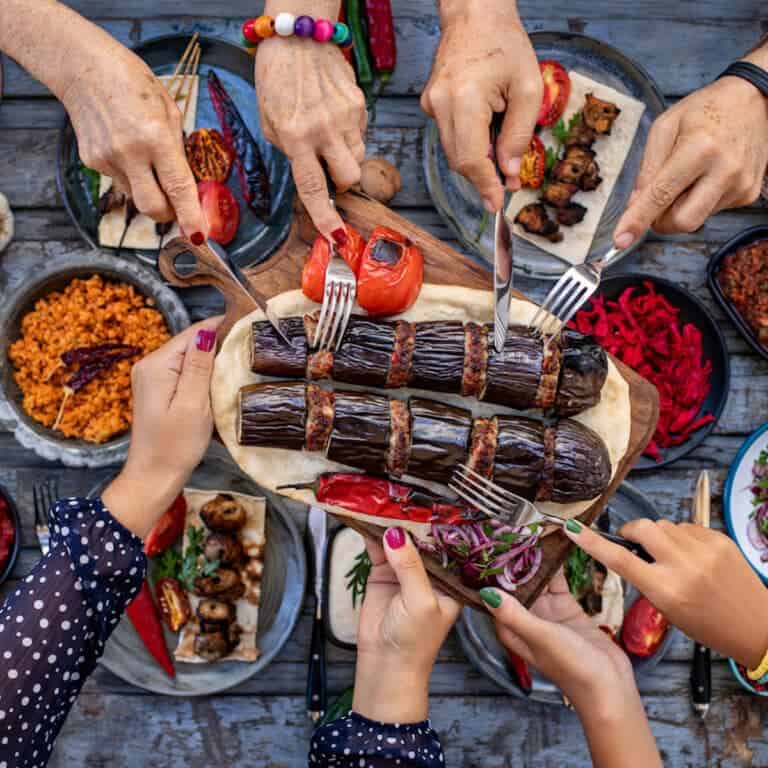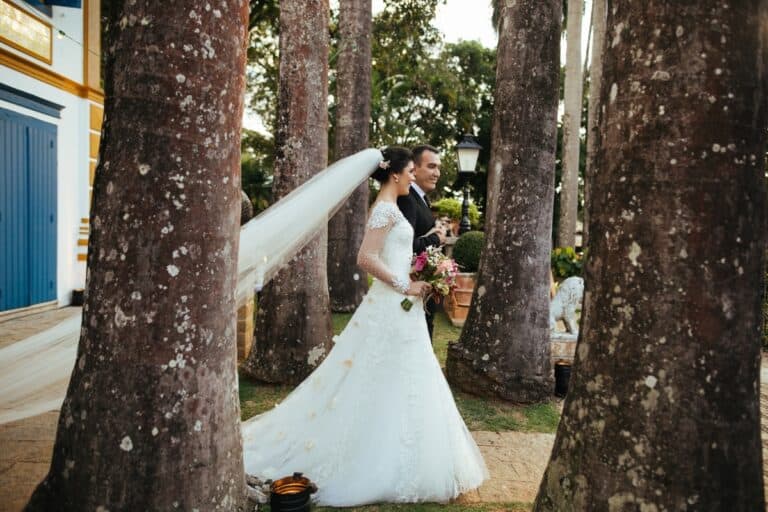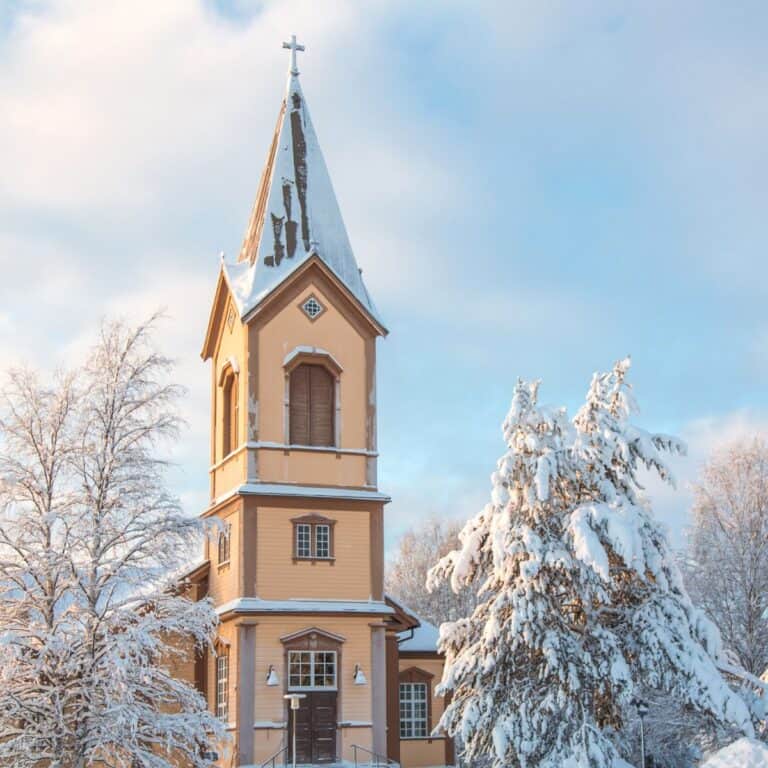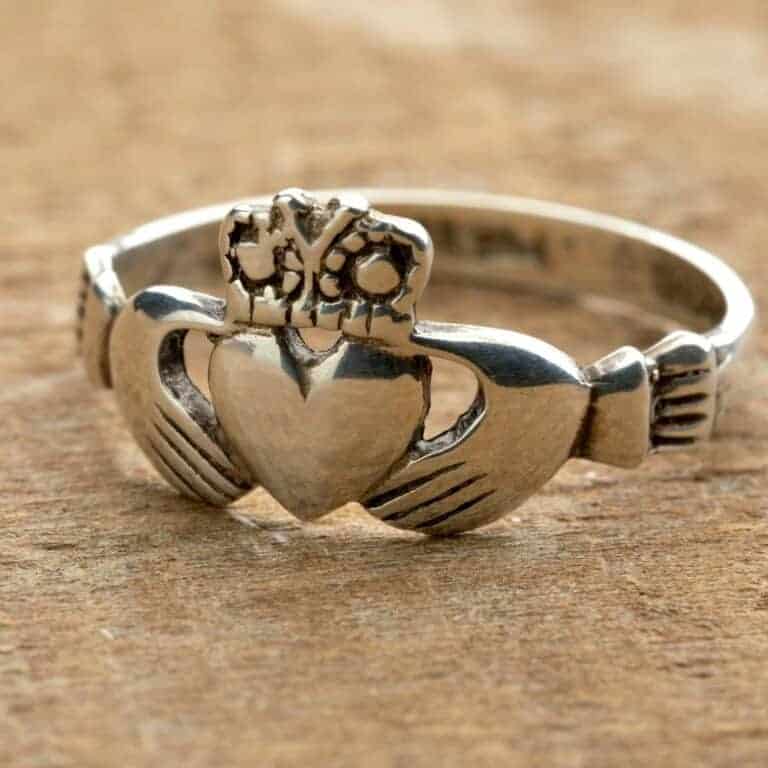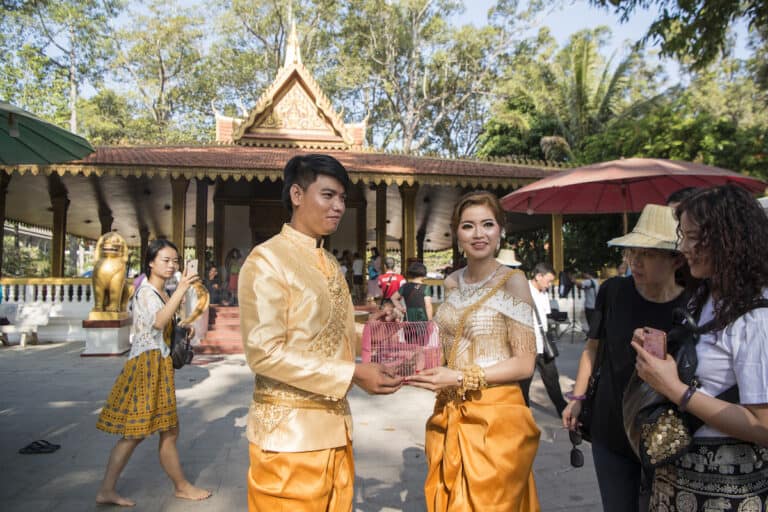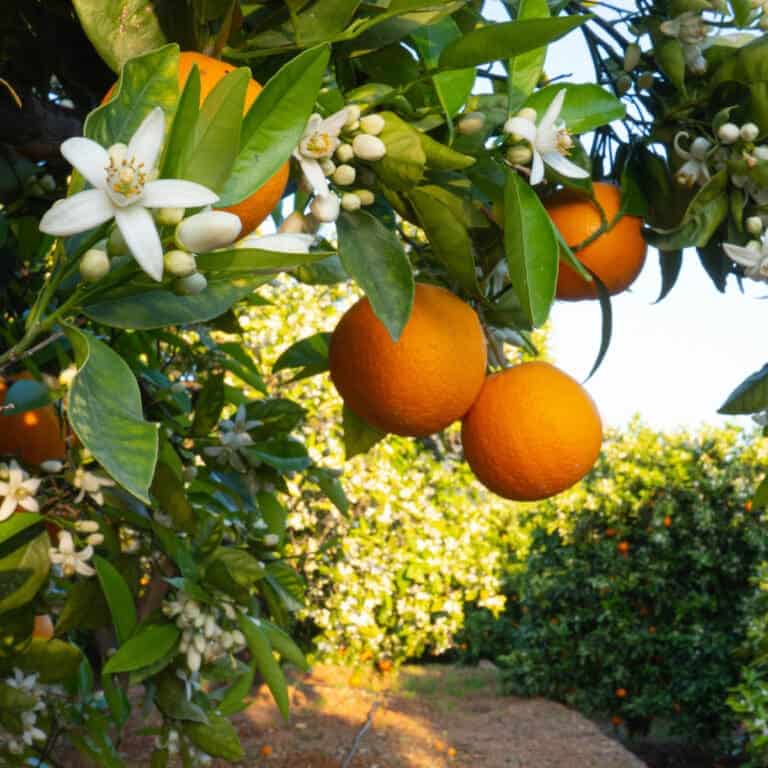A look into 1940s Weddings
The 1940s was a decade defined by the impact of World War II on every aspect of daily life, including how people celebrated their weddings. With a backdrop of war, uncertainty, and rations, weddings during this era had a unique charm that showcased the resilience and adaptability of couples in love.
These “wartime weddings” often featured short engagements, intimate ceremonies, and resourceful ways to make the most of limited materials. In this post, we’ll explore the fascinating world of 1940s weddings, from fashion to food, and show how love triumphed in the face of adversity.
The influence of WW II
The 1940s “wartime weddings” usually involved a short engagement and a wedding reception stretched on wartime rations. The events of World War II heavily influenced wedding traditions during this era, and short engagements and rushed weddings on a budget were commonplace.
During this period, weddings were often intimate affairs, celebrated with close family and friends. Due to wartime rationing, brides would frequently wear borrowed or repurposed dresses, and the decorations were often homemade. Although this didn’t dampen the spirits of the happy couple. They found joy in the simple things and focused on the love they shared.
As the early ’40s saw many men leaving with little notice to travel overseas to fight in the war. Weddings that did take place were often planned quickly and with limited resources. Relatives catered, mothers sewed the bride’s dress, and families saved their ration coupons all to contribute to the special event.

1940s Wedding Fashion
Simple and Modest
During war times, it was common for women to adopt a more practical and modest approach to fashion. This was due to a scarcity of materials and resources. While silk and satin were rationed, fabrics such as tulle and lace were used to make wedding gowns. Lightweight synthetic fabrics such as rayon and taffeta were more affordable so many brides opted for these also.
These materials were sold to the public to boost morale during tough times when more costly options weren’t available or affordable.
Many wedding parties even opted to wear their best suits and dresses for the occasion. Sunday best dresses, ball gowns, or borrowed wedding dresses from a friend or relative were commonplace. Some brides even opted to wear their mother’s vintage wedding gown. By changing out the trim, and sleeves or adding embellishments such as buttons and beading a whole new dress could be constructed.
Women’s dresses were typically more conservative in style and fabric during the war, and this was the same for wedding gowns. Many future brides opted for a shorter dress rather than a traditional long gown. Long trains were considered a waste of fabric, so shorter trains became more popular.
Early 1940s Wedding Dress
Gowns typically featured a subtle, yet elegant silhouette. A-line and ballgown styles were popular options due to their flattering and functional cut. A fitted bodice, that cinched at the waist. And a skirt that draped and ruched to the floor was used to create visual interest and enhance the bride’s figure. These techniques added texture and depth to the gown with limited resources.
A defining feature of the 1940s wedding gown was the sweetheart neckline. This romantic design element is characterized by a curved neckline that gently slopes to form a heart shape. Beautifully framing the bride’s face. The sweetheart neckline exuded femininity and grace, while also offering a modest yet pleasing look.
With the restrictions on white silk, rose pink became a favored color choice for 1940s wedding dresses. The soft pink hue offered a romantic alternative, while still maintaining a sense of tradition and elegance.
Uniformed servicewoman sometimes wore their uniforms for their special day. However, many still chose the more elegant look of a wedding dress.

Post-war 1940s Wedding Dresses
Wedding dresses post-war started to move away from the restrictions of the early part of the decade. Brides started to incorporate more elaborate designs and luxurious fabrics.
One of the most noticeable changes in post-war wedding dress styles was the introduction of full skirts. The end of fabric rationing allowed for more generous amounts of material to be used, resulting in voluminous skirts that added a sense of drama and grandeur to the bridal ensemble.
As resources became more readily available, brides had access to a wider range of luxurious fabrics. Satin, silk, and lace were popular choices again. Adding a touch of luxury and glamour to the post-war wedding gown.
Parachute Dresses
Using parachute silk to make wedding dresses became common during and after the war. Women were eager to ensure nothing went to waste during these challenging times. Parachute silk was a lightweight, durable fabric used to make parachutes for the army. Women whose husbands had used the parachute to jump out of a plane during the war repurposed the silk for their wedding dresses. This resourcefulness saw the return of the long train. Parachute fabric made of pure silk in the color cream made for a beautiful dress.
Parachutes were brought back by the men as keepsakes. If the chute was deemed unfit for use, which many were after their soldiers had used them to land in seawater, they were permitted to keep them. Some men even bought home parachute silk from the enemy soldiers who had been killed.

Accessories
During the 1940s, veils were an essential component of the bridal outfit. The long single-layer net veil was a popular choice. Offering a delicate touch to the bride’s overall look. This simple yet elegant veil would often be fingertip length.
A pillbox hat was often adorned with a veil, creating a graceful and refined look. The veil was made of fine netting and covered just the face or extended to the shoulders. Flower crowns or headbands of seasonal flowers could also be used to attach the veil to the head depending on the bride’s preference.
Hairstyles that complemented these headpieces included soft waves, sleek chignons, or elegant updos. The key was to create a harmonious balance between the hat, veil, and hairstyle, ensuring that each element worked together to create a cohesive and beautiful look.
Long sleeves, often made from lace or satin, were a common feature of 1940s wedding dresses. They provided modesty and sophistication while also offering additional warmth during cooler months.
A white pearl necklace was favored and often the only piece of jewelry worn by the bride.
Brides often chose to wear practical and understated shoes, as high heels were difficult to purchase during the war.
Men’s Fashion
With so many men in the armed services at the time, it was common for the groom to wear his military uniform. As was seen by Prince Philip on his wedding day to Princess Elizabeth, the future queen.
A 1940s groom also had to make do in these hard times. Some grooms choose to wear their tidiest business suits. Many men had to make do with their older suits from before the war. Typically, grooms opted for a suit in dark colors such as navy, black, or charcoal grey.
New suits were made with a wool-rayon blend instead of wool. Single-breasted suits replaced double-breasted ones to preserve materials. Suits and shirts were made more simple with fewer pockets and thinner lapels. Trousers were no longer allowed to be cuffed. However, men often purchased a longer size and had them altered if they could afford such luxuries.
A crisp white dress shirt was a staple of the 1940s groom’s outfit. Often featuring a point or semi-spread collar. The shirt was typically paired with a coordinating tie. Popular patterns for ties included stripes, polka dots, and geometric designs, adding a touch of personality to the outfit.
While not essential, many grooms in the 1940s chose to wear a hat as part of their wedding outfits. The fedora, with its distinctive wide brim and pinched crown, was the most popular choice. Offering a stylish and distinguished look. Other options included the Homburg or the Trilby, each adding a touch of classic elegance to the groom’s attire.
They also wore a corsage pinned to the lapel of their jacket. They frequently wore white carnations or flowers matching the bride’s bouquet.
The best man would be dressed in very formal attire, similar to the groom.
Bridesmaids
Bridesmaid dresses of the 1940s typically featured modest and feminine silhouettes. They played a key role in defining the aesthetic of the day. Stylish and functional dresses reflected the era’s fashion trends. A-line, tea-length, and peplum skirts added a touch of sophistication and femininity.
The dresses were a similar cut to the bride’s: knee or floor length. The sleeve length varied, but short or capped sleeves were popular. Favored colors included pastel blues, yellows, pinks, and greens. It was typical for bridesmaids to wear a hat, hairpiece, or short veil. They also carried a bouquet similar to the brides.
Wedding Flowers
Wedding flowers were generally simple, elegant, and understated. Due to wartime restrictions, brides often made do with whatever flowers were available. As weddings were usually rushed, some brides would have to make do with garden flowers.
- Roses: Roses were popular as wedding flowers in the 1940s, symbolizing love and romance. Garden roses were trendy due to their delicate fragrance and vintage charm.
- Carnations: Carnations were also commonly used in wedding arrangements during the 1940s. They were available in a variety of colors and were relatively affordable.
- Lily of the Valley: This delicate flower was popular in bridal bouquets in the 1940s due to its sweet fragrance and dainty appearance.
- Sweet Peas: Sweet peas were another popular choice for wedding flowers in the 1940s. They were chosen for their soft, pastel hues and delicate fragrance.
- Peonies: Large, fluffy peonies were a popular choice for wedding flowers in the 1940s, adding a touch of elegance and sophistication to bridal bouquets.
- Baby’s Breath: This delicate white flower was often used as a filler in wedding arrangements, adding a soft and airy feel to the overall design.
- Gardenias: Gardenias were a popular choice for bridal bouquets due to their fragrant scent and delicate, creamy white petals.
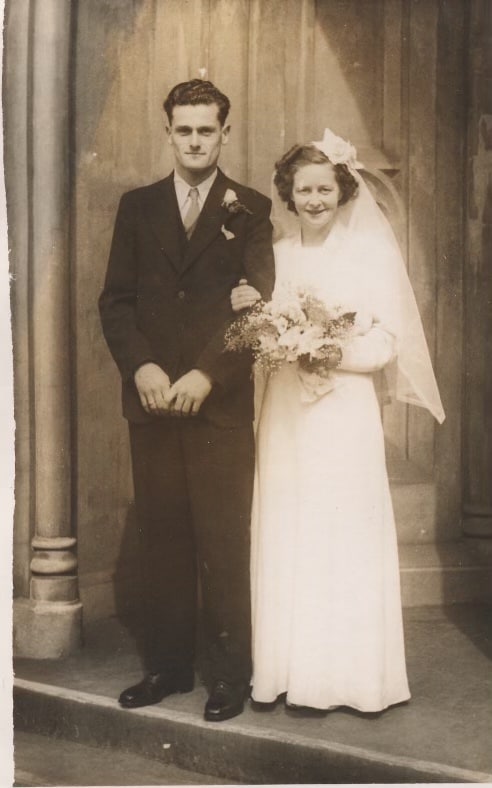
At Home Weddings
With venues and rations scarce, home weddings were a popular option for many couples. With resources low, smaller intimate weddings were typical. After the church ceremony, guests returned to the bride’s parent’s house for a light meal and wedding cake.
Nonetheless, even with many foods in short supply, some love birds could still put on a larger wedding. They would hire a venue for a lavish affair with live music and dancing to boost people’s spirits.
Entertainment
Resourceful couples in the 1940s often came up with creative ways to entertain their guests. Homemade games, such as horseshoes, sack races, and bingo, were common at outdoor receptions. Guests would also be encouraged to participate in sing-alongs, with someone playing the piano or accordion as others joined in with their favorite songs. This interactive entertainment fostered a sense of connection and ensured that everyone was involved in the festivities.
Music and dancing were at the heart of 1940s wedding celebrations. Live bands were popular, and guests would dance the night away to the tunes of swing, jazz, and big-band music. The jitterbug, foxtrot, and waltz were the dances of choice, as couples glided across the dance floor. Some weddings also incorporated traditional folk dances, a nod to the cultural heritage of the bride and groom.
Music
Hit songs performed by live bands at wedding receptions were chosen for their romantic lyrics and danceable rhythms. The music of the 1940s reflected the cultural values of the time, which emphasized romance, love, and commitment, making these songs still popular for weddings today.
For couples who couldn’t afford a live band, the radio and record players provided a more affordable alternative. Wedding guests would gather around the radio or record player, listening to the latest hits or timeless classics. This created a cozy atmosphere, with loved ones sharing in the couple’s joy and toasting their future together.
“Paper Doll” by Mills Brothers, “Moonlight Cocktail” by Glenn Miller, Swinging on a Star” by Bing Crosby were popular hits of the 1940s.
Dancing
Dancing was a significant part of wedding entertainment in the 1940s, and guests were encouraged to participate in the festivities.
Even through the tough times, music and dance were popular sources of fun to boost spirits. In the early and late 1940s, dance floor styles included the Jive, Jitterbug, foxtrot, and swing.
Arguably the most iconic dance of the 1940s, the swing morphed from the Jitterbug and African American jive.
Some of the most popular swing dance styles of the 1940s included the Lindy Hop, Jitterbug, and East Coast Swing. Swing dancing was depicted by its lively and upbeat music. Performed by big bands and features a strong rhythm with brass and woodwind instruments. The dance featured a distinctive back-and-forth motion, with dancers taking turns leading and following one another in various complex steps and turns.
The Lindy Hop evolved from earlier dances such as the Charleston and the Breakaway, and it quickly gained popularity throughout the 1930s and 1940s. It was a significant cultural phenomenon during World War II, and it played a crucial role in bringing people of different races and backgrounds together through music and dance.
Food and Drink
The bride’s family and parents’ friends often catered for wedding food. Those who could afford to hire a venue. Menus were created around food rations and catered for on a budget.
- Roast beef or chicken with gravy – Roast beef and poultry were classic choices for wedding entrees in the 1940s.
- Potatoes – Either mashed or roasted potatoes were a popular option for weddings.
- Green beans or other seasonal vegetables – Seasonal vegetables were easier when rations were low. Home gardens were a source of food to cater for weddings in these challenging times.
- Salad with dressing – Due to their ease of being made in advance, they are ideal for large gatherings.
- Rolls or bread – A filling side option that could be made at home from limited ingredients
- Wedding cake – Limited rations meant wedding cake bakers had to improvise. A fruit cake was popular for some couples, but many opted for spice cakes made with shortening and no eggs. Multi-tiered wedding cakes were rare in the early 40s but were making a comeback in the later years.
- Coffee or tea – Enjoyed with the wedding cake as an end-of-the-evening treat.
Additionally, hors d’oeuvres such as devilled eggs, shrimp cocktails, and stuffed mushrooms were also common during this period. These dishes were served buffet-style or family-style, and the emphasis was on hearty and filling fare that could feed many guests if you were able.
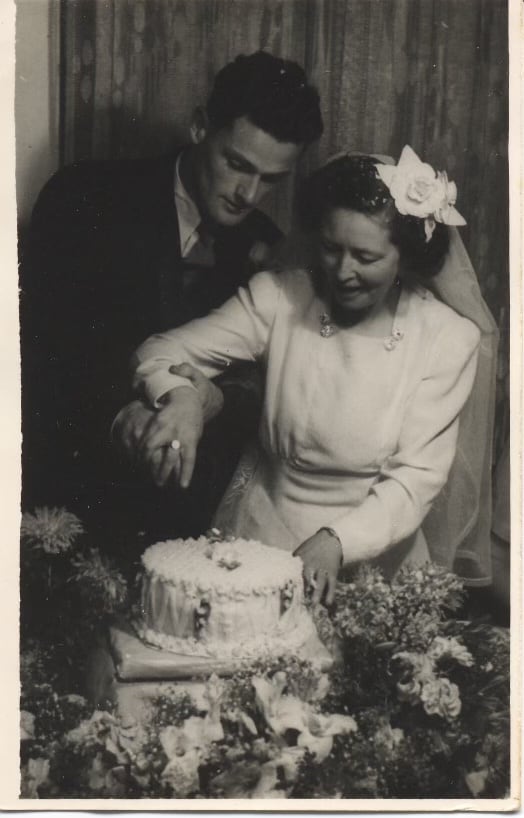
Final thoughts
The wartime weddings of the 1940s were planned around short engagements, the deployment of men to the war, and the struggles of food rations. But many a happy marriage took place during this era leading to a baby boom in the mid to late 40s. Weddings were smaller intimate affairs with brides DIYíng everything from their dresses to their bouquets and family pitching in to help with supplies and the reception.
Although it had been a tough two decades the end of the 1940s saw the beginnings of a prosperous future and a baby boom to follow.

